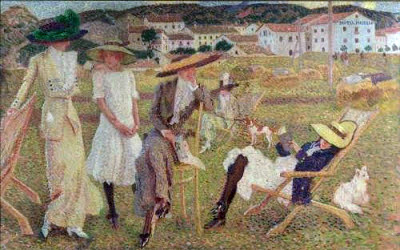Poor Camillo Inoocenti (1871-1961). Unlike some of his fellow painters, Innocenti gets no entry in the Grove Dictionary of Art, even in the wake of the ground-breaking 2008 exhibition Radical Light: Italy's Divisionist Painters, 1891-1910 at London's National Gallery. One reason often given for the neglect of the Italian painters is their lack of group cohesion, sometimes also know as self-promotion. Of course, some of the cohesion attributed to other groups of artists has been applied from the outside by critics, the artists themselves being busy with more pressing concerns like where to apply the paint brush.
In The Cottagers Innocenti painted something he had seen frequently while growing up. Before air-conditioning, it was the custom among the bourgeoisie for the wives, children - and even pets - to decamp during the heat of the summer months in the cities to the countryside in search of cool air and relaxation. Still, women and girls were careful to shield their skin from the effects of the sun, hence the hats and stockings; relaxed though their postures may be as they lounge on lawn chairs, to our eyes they are dressed for company more than for an intimate family tete-a-tete. Innocente was known for his portrayals of women, turning from the conventional female figure
in elegant déshabillé, to more sensitive and nuanced images. The Cottagers, an inter-generational gathering, is one of Innocenti's finest meditations on the stages of women's lives, captured in the doldrums between the defining seasons of education and marriage. An element of that fineness is how the artist managed to rise above his own rather conventional ideas about women with his brush: " ...woman is mysterious, fragile, mutable, impassioned and also artificial ."(translation by JL).
Like innumerable other aspiring artists, the young Innocentei was encouraged to pursue a less uncertain career. His father thought the classics would be a more suitable field for the son of successful architect but, at age twenty-four, Camillo realized that he preferred drawing while working as an assistant to the decorator of the Candelabra Gallery at the Vatican. Three years later
he was admitted to the Rome Institute of Fine Arts. Disappointed by his academic studies, he began searching for a fresher style. In 1901 in Spain, he encountered the paintings of Goya and Velazquez, but it was as much popular scenes and landscapes that attracted him as the old masters.
Back home in 1903, Innocenti gravitated to the divisionist painters, their youth and their sense of liberty from the old academic rules. Following World War I, he did set decoration in the up and coming Italian film industry on such projects as Cyrano de Bergerac and Ben Hur. Had he not detoured to Cairo for a fifteen year stint as director of its School of Fine Arts (from 1925 to 1940), he might not have been so easily forgotten by his countrymen. His work is the collection of the National Gallery of Modern Art, and in several other Italian museums.
Image:
Camillo Innocenti - The Cottagers, 1912, National Gallery of San Luca, Rome.


6 comments:
Great info, thanks.
Philip Lemarque
bonjourneverland.com
There is so much that one could speculate about the relationships between these people but what struck me first was how the picture works as an image, allowing you to think about them. It makes me think of John Singer Sargent's "The Daughters of Edward Darley Boit." Something else I noticed is how the chair at left (clipped off the edge of canvas) suggests the influence of, or at least familiarity with, photography. The date on this is 1912.
I have yet to see another painting by Innocenti that I like nearly so much; I'm glad you looked it also.
Your detailled information about each artist is invaluable, great work. Thanks
Thanks, Maurice. In the case of Innocenti, and many other artists I've written about here, I choose to focus on a work or a few works that I especially like. I'm not doing a term paper, so it's author's privilege!
You are right no one can be fair reviewing work that you do not like. I personaly like the impressionists, since I am the guardian of my father's work from that period.
Maurice, your comment makes me think of something that an artist who studied in Florence told me: "No one ever tells you how many bad paintings there are in the Uffizi." When a person stakes their academic career on an artist, it can be difficult to voice dissent. Maybe that's connected to what the physicist Max Placnk meant when he said, "Science progresses one funeral at a time."
Post a Comment